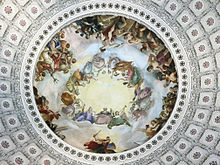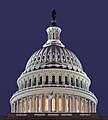Amerika Qo'shma Shtatlari Capitol Rotunda
Категория:Антропогенные географические объекты по алфавиту Категория:ПРО:АГЕО:Последняя правка: в текущем году
Amerika Qo'shma Shtatlari Capitol Rotunda (inglizcha: United States Capitol rotunda) Kolumbiya okrugidagi Vashington shtati Kapitoliysining markaziy rotundasi, Qoʻshma Shtatlar . Kapitoliyning ulkan gumbazi ostida joylashgan. Xona binoning "ramziy va jismoniy yuragi" sifatida yaratilgan.
Rotunda koridorlar tarmog'i bilan o'ralgan bo'lib , Vakillar palatasi Kapitoliyning yarmini Senatning yarmi bilan bog'laydi. Janubda 1859-yilgacha Vakillar palatasi yig'ilgan yarim doira shaklidagi Национальный скульптурный зал США . Rotunda shimoliga ulashgan Старый кабинет Сената США joylashgan bo'lib u erda 1857 yilgacha yig'ilishlar o'tkazgan.
Rotondaning diametri 29 metr, shiftgacha bo'lgan balandligi taxminan 55 metr. Bu joy sayyohlar orasida juda mashhur. Boshqa narsalar qatorida, rotundada taniqli odamlar, shu jumladan AQSh prezidentlari bilan xayrlashishgacha bo'lgan rasmiy tadbirlar o'tkaziladi.
Arxitektura[tahrir | manbasini tahrirlash]
1793- yilda Kapitoliyning eng yaxshi dizayni uchun tanlov bo'lib o'tdi. Amerikalik shifokor va arxitektor Торнтон, Вильям g'olib bo'ldi/ U Kapitoliyda rotunda qurish g'oyasiga ham ega edi. Biroq, mablag' va resurslarning etishmasligi, shuningdek , 1812-yilgi Angliya-Amerika urushi paytida Britaniyaning Vashingtonga Вашингтонский пожар tufayli me'morning rejasi amalga oshmadi. Bino ustidagi ishlar faqat 1818-yilda davom etdi.
-
Uilyam Tornton
-
1812-yilgi yong'indan keyin Kapitoliy
-
1800 yilda Kapitoliy - hali ham Rotundasiz
Rotunda 1824-yilda Kapitoliy me'mori Балфинч, Чарльз rahbarligida yakunlandi fransuz inqilobchisi Mari-Jozef Lafayette tashrifi uchun. O'sha paytda, gumbaz va rotunda, butun Kapitoliy kabi, neoklassik uslubda qurilgan va Rim Panteoniga o'xshardi.
-
Charlz Bulfinch
-
1846 yilga kelib Kapitoliy
-
Купол Пантеона в Риме
Rotundaning qumtosh devorlarining poldan balandligi 15 metr (48 fut). Tez orada bu balandlik ko'tarildi. 1854-yilda Kapitoliyning to'rtinchi me'mori Уолтер, Томас Юстик tashabbusi bilan binoning ustki tuzilishi ustida ish boshladi. Xususan, o'sha davrlar uchun misli ko'rilmagan gumbaz qurilishi boshlandi. Rotunda ham kengaytirildi. Qayta qurish Tomas tomonidan ishlab chiqilgan dastlabki loyihaga muvofiq amalga oshirildi. Arxitektorning rejalariga ko'ra, rotunda ustiga ikkita gumbaz o'rnatilgan: ichki va tashqi. Tashqi qismini baraban bo'ylab ustun bilan yakunlash rejalashtirilgan edi. Tashqi gumbaz Londondagi Avliyo Pol soborini eslatishi kerak edi. Ichki qismning tepasi yo'q edi, aylana shaklida o'ziga xos teshik paydo bo'lgan, shunda u orqali tashqi gumbazning ichki yuzasiga qo'llaniladigan freskani ko'rish mumkin edi.
-
Tomas Valter
-
Ikki qavatli gumbazning koʻndalang kesimi
-
1861 yilda rotunda qo'shilishi
Tomas Uolter tarixiy rassom[1] Brumididan "o'sha teshikka diametri 65 fut (20 metr) bo'lgan, yangi AQSh Kapitoliy gumbazi ko'zining konkav soyaboniga freskalangan rasmni bo'yashni" so'radi.
...a picture 65 feet (20 m) in diameter, painted in fresco, on the concave canopy over the eye of the New Dome of the U.S. Capitol
1859-yilga kelib, kelajakdagi freskaning turli xil sahnalarining akvarel eskizlari allaqachon tayyor edi. Fuqarolar urushining o'rtalarida Kapitoliy gumbazi tayyor edi. Gumbazning ramkasi yong'inni istisno qiladigan quyma temirdan yasalgan . Fuqarolar urushi davrida rotunda ittifoqchi kuchlar uchun kasalxona sifatida moslashtirilgan. Gumbaz ustida to'liq ish 1866- yilda yakunlandi. Yuqori tuzilishdan so'ng Kapitoliy allaqachon Parij Panteoniga o'xshay boshladi.
-
Konstantino Brumidi
-
Kapitoliyning yangi gumbazi
-
Parij panteonining gumbazi
Vashingtonning apofeozi[tahrir | manbasini tahrirlash]

Amerika tarixi friz[tahrir | manbasini tahrirlash]
Barelyeflar[tahrir | manbasini tahrirlash]
| Сцена | Описание |
|---|---|

|
Америка и История inglizcha: America and History На первом барельефе представлена аллегорическая сцена. На первом плане изображена Колумбия — олицетворение Америки с фригийским колпаком на голове, копьём и щитом в руках. Справа сидит, вооружённый луком и стрелами Индеец. Он представляет американскую землю. У ног Америки сидит аллегория Истории, записывающая на каменной плите события. Рядом с Историей на символизирующей власть фасции примостился Орёл. |

|
Прибытие Колумба inglizcha: Landing of Columbus Christopher Columbus is depicting arriving in the Americas in the first of four scenes of the Spanish conquest. Columbus disembarks off a plank from the Santa María. His crew, armed with weapons, stays aboard; one crew member has a spyglass. Native Americans are portrayed greeting Columbus. Indian women and children are shown, along with native warriors to the right. The Columbus figure may have been based on Luigi Persico statue of Columbus, which was at the time of the painting the on the east central steps of the Capitol. |

|
Кортес и Монтесума в храме Ацтеков inglizcha: Cortez and Montezuma at Mexican Temple This panel shows the Spanish conquistador Hernán Cortés entering an Aztec temple, being welcomed by Moctezuma II. At the beginning of the Spanish conquest of the Aztec Empire, Moctezuma and the Aztecs honored Cortés as a god, believing that he was the returning god Quetzalcoatl. The Aztec sun stone and cult images are based on sketches drawn by Brumidi in Mexico City. |

|
Поход Писарро в Перу inglizcha: Pizarro Going to Peru Spanish conquistador Francisco Pizarro is depicted leading his horse through the jungle in search of El Dorado, the mythical land of gold, in this representation of the Spanish conquest of the Inca Empire. |

|
Похороны Десото inglizcha: Burial of DeSoto This panel depict the burial of Spanish explorer Hernando de Soto in the Mississippi River after his death from a fever. De Soto has led the largest European expedition of both 15th and 16th centuries through the Southeast and Midwest searching for gold, silver, and other valuables. |

|
Капитан Смит и Покахонтас inglizcha: Captain Smith and Pocahontas Pocahontas is portrayed saving Captain John Smith, one of the founders of Jamestown, Virginia, from being clubbed to death. |

|
Прибытие пилигримов inglizcha: Landing of the Pilgrims Pilgrims led by William Brewster give thanks to God for their safe voyage in this scene depicting Plymouth Colony. |

|
Вилльям Пенн и индейцы inglizcha: William Penn and the Indians Quaker leader and Province of Pennsylvania founder William Penn is depicted with Lenape (Delaware) Native Americans under the elm tree at Shackamaxon. This is the last panel on which Brumidi worked. |

|
Колонизация Новой Англии inglizcha: Colonization of New England This panel shows New England settlers busily logging, sawing, and using lumber to construct a building. This is the first scene painted entirely by Costaggini. |

|
Оглетроп и Индейцы inglizcha: Oglethorpe and the Indians James Oglethorpe, founder of Georgia Colony and first Georgia governor, is shown with the Muskogee (Creek) leaders in Savannah, Georgia. The Muskogee present Oglethorpe with a buffalo skin with an eagle in the center, a symbol of friendship and trust. |

|
Битва при Лексингтоне inglizcha: Battle of Lexington This panel depicts the «shot heard 'round the world» at the Battle of Lexington, the first major battle of the American Revolutionary War. Major John Pitcairn is shown on horseback at center, with British Army or Royal Marines troops to the right and Lexington militiamen at left. |

|
Декларация Независимости inglizcha: Declaration of Independence Idealized depiction of John Adams, Thomas Jefferson, and Benjamin Franklin, authors of the Declaration of Independence, reading the declaration to celebrating colonists. |

|
Сдача Корнуоллиса inglizcha: Surrender of Cornwallis Depiction of George Washington on horseback receiving the ceremonial sword of surrender from Charles O'Hara, who represented Lord Cornwallis after the final British defeat at the Battle of Yorktown. In reality, it is thought that Washington declined O’Hara’s sword because according to the custom of the time it would only be proper for Washington to receive the sword from Cornwallis himself; Major General Benjamin Lincoln instead accepted the sword. |

|
Гибель Текумсе inglizcha: Death of Tecumseh This panel depicts the death of Shawnee chief and Indian Confederation leader Tecumseh at the Battle of the Thames in Upper Canada during the War of 1812 (partially an extension of Tecumseh's War). |

|
Взятие Мехико американской армией inglizcha: American Army Entering the City of Mexico U.S. Army troops led by Winfield Scott enter Mexico City after the fall of Mexico City, which ended the Mexican-American War with a decisive American victory. The 1848 Treaty of Guadalupe Hidalgo, which provided for the massive Mexican Cession of territory in what is now the Western United States. |

|
Обнаружение золота в Калифорнии inglizcha: Discovery of Gold in California Prospectors dig and pan for gold with picks, shovels, and other tools in this depiction of the California Gold Rush. In the center, three men (one possibly representing John Sutter) examine a prospector’s pan. This was the last scene designed by Brumidi and painted by Costaggini. |

|
Мир и Конец Гражданской войны inglizcha: Peace at the End of the Civil War This scene, the first of Allyn Cox’s three panels, depicts a Confederate soldier and a Union soldier shaking hands at the end of the American Civil War, symbolizing reconciliation and reunification. The cotton plant and the Northern pine tree symbolize the South and the North. |

|
Орудие в Испано-Американской войне inglizcha: Naval Gun Crew in the Spanish-American War A group of United States Navy sailors in a gun crew are depicted in a naval battle during the Spanish–American War. and the United States won a victory over Spain in the war. The 1898 Treaty of Paris provided for Cuba’s independence from Spain and the American acquisition of Puerto Rico, Guam, and the Philippines. |

|
Рождение авиации inglizcha: The Birth of Aviation This scene depicts the Wright brothers' first flight at Kitty Hawk in 1903. The Wright Flyer is shown just off the ground, with Orville Wright in the plane and Wilbur Wright running alongside to steady the wing. To the left are Leonardo da Vinci, Samuel Pierpont Langley, and Octave Chanute, other aviation pioneers, holding models of earlier designs for the first flying machine. An eagle holds an olive branch in the bottom right. |
Adabiyot[tahrir | manbasini tahrirlash]
- William C. Allen. History of the United States Capitol: A chronicle of design, construction, and politics. Washington, D.C.: U.S. Government Printing Office, 2001.
- ↑ Wolanin, Barbara A.. Constantino Brumidi: artist of the Capitol. Washington: U.S. Government Printing Office, 1998.












